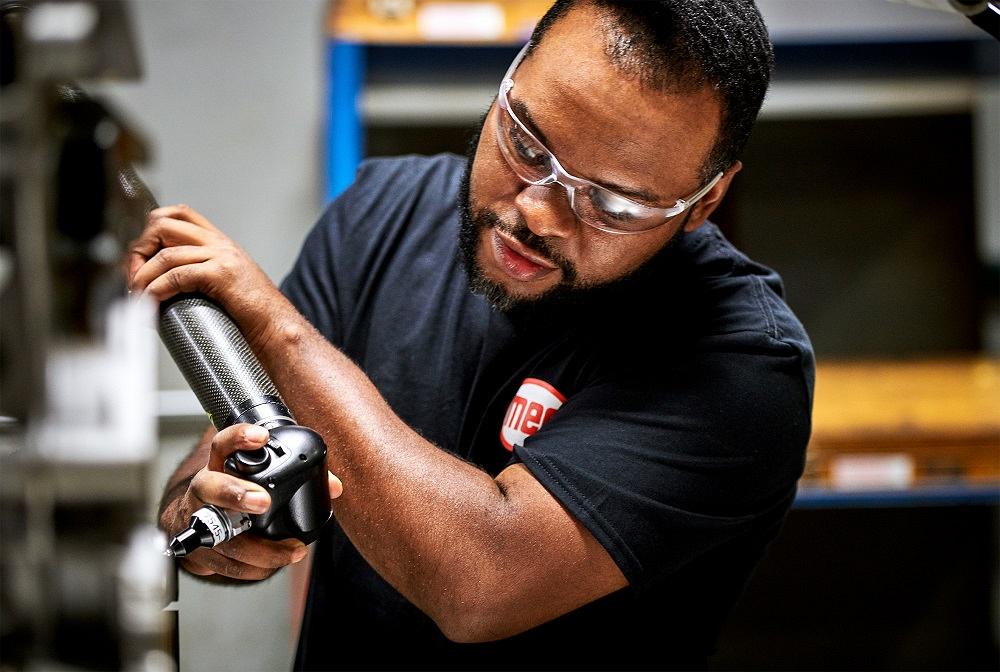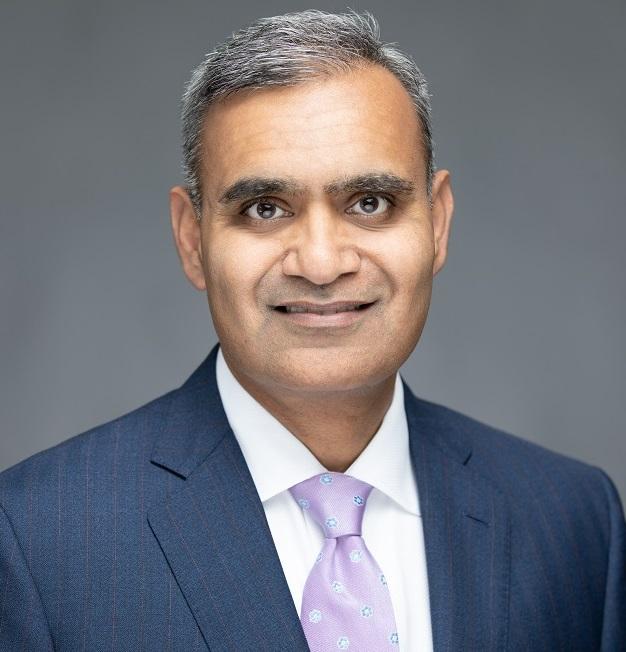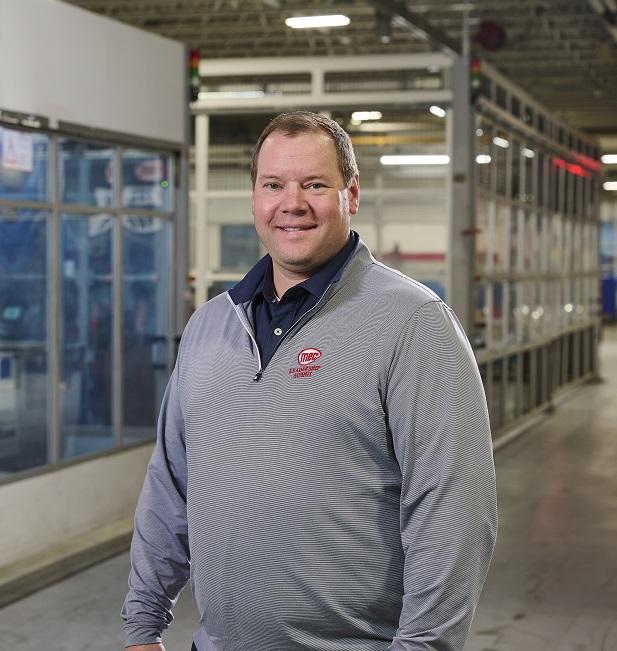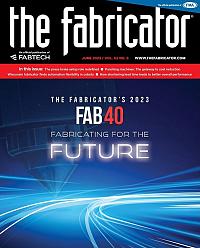Senior Editor
- FMA
- The Fabricator
- FABTECH
- Canadian Metalworking
Categories
- Additive Manufacturing
- Aluminum Welding
- Arc Welding
- Assembly and Joining
- Automation and Robotics
- Bending and Forming
- Consumables
- Cutting and Weld Prep
- Electric Vehicles
- En Español
- Finishing
- Hydroforming
- Laser Cutting
- Laser Welding
- Machining
- Manufacturing Software
- Materials Handling
- Metals/Materials
- Oxyfuel Cutting
- Plasma Cutting
- Power Tools
- Punching and Other Holemaking
- Roll Forming
- Safety
- Sawing
- Shearing
- Shop Management
- Testing and Measuring
- Tube and Pipe Fabrication
- Tube and Pipe Production
- Waterjet Cutting
Industry Directory
Webcasts
Podcasts
FAB 40
Advertise
Subscribe
Account Login
Search
2023 FAB 40: Metal fabrication leader gears up for continued growth as global supply chains shift
MEC, No. 1 on 13 consecutive FAB 40 lists, has nearly quintupled its sales since 2010
- By Tim Heston
- Updated June 6, 2023
- June 6, 2023
- Article
- Shop Management

MEC’s headcount has decreased by more than 1,000 over the pandemic. Most of that has come from attrition, and the company is still hiring, with open positions at every plant. When workers leave or retire, MEC still rehires, just not the same number. Images: MEC
Before arriving at MEC, Jag Reddy helped other companies build and expand plants in China, India, Mexico, and the Middle East. He’s managed sales operations on six continents, manufacturing plants on five.
“I’ve spent the better part of my career building and counseling global businesses,” Reddy said. “Several years back, I began to see an increased trend toward a more secure, localized supply chain, one where robust domestic manufacturing partners would become a key competitive advantage. I knew that MEC, with its stable of premium customers and proven operating track record, would be a key beneficiary of this long-term trend.”
Reddy took the president and CEO role at Mayville, Wis.-based MEC in July of last year, taking over for Bob Kamphius, who retired after shepherding the manufacturer through years of growth. The company has held the top spot on FAB 40 since 2011, and over that time, sales have nearly quintupled. MEC’s 2010 revenue was $111 million; in 2022, sales surpassed $532 million.
Like most FAB 40 participants, MEC’s leaders aren’t expecting a significant slowdown, despite news of a recession on the horizon. In fact, as shared on its first quarter 2023 conference call, MEC is forecasting 2023 sales to be between $540 million and $580 million. Long term, though, MEC has grander growth plans.
“Now, we’re planning to take MEC to the next level,” Reddy said, adding that growth could reach new heights as global industrial players rethink and reshape their supply chains. “Can we double our size within the next five years? Thinking about where we are today, our efficiencies, our automation, and the overall investments MEC has made over the past five years, it’s entirely possible.”
A New Approach to Consolidation
“Throughout the pandemic, we never blinked. We never turned away a customer, while remaining a trusted partner during a challenging period. Still, coming into the CEO role, I’m asking, ‘How else can we better serve our customers while driving sustainable, profitable growth for our business?’”
Reddy’s question isn’t novel. For years, the industry’s largest players have benefited from OEMs wanting to simplify and consolidate their supply chains; then came the pandemic and the ensuing supply chain headaches.
Is a supply chain consolidation strategy still valid? It is, Reddy explained, but the strategy isn’t just about grabbing new market share and acquiring more and more fab shops. The post-pandemic reality requires a bit more strategy.
“Given the COVID experience and where we think we can support our customers, I expect MEC to be a consolidator into the future,” Reddy said. “But more importantly, what are we consolidating? Yes, we could buy more metal fabrication operations, as we’ve done in the past, but are there other areas where our customers need help?”
Here, Reddy said, new kinds of demand pushed by, among other things, trends in electric vehicle manufacturing are trickling down to the metal manufacturing sector. It’s not just about conventional metals anymore.

Jag Reddy, president and CEO, joined MEC in July 2022. He spent years building overseas supply networks for global manufacturers. Now at MEC, he sees that trend reversing, and—like others on the FAB 40—MEC stands to benefit.
“Customers have told us, ‘We love what you guys do, but trends around lightweighting are becoming more important,’” Reddy said. “Every one of our customers will be converting to electric sometime in the future, be it a Class 8 truck, tractor, or even earth-moving equipment. How do we support our customers’ future? We’ll always be a steel fabricator, but we’ll be putting a new focus on lightweight materials … This positions us to ramp our M&A effort by entering new areas.”
Greater focus on aluminum fabrication is in the immediate future, with the transition to plastics and composites a little further down the line. “In these areas, we’re beefing up our M&A pipeline and have hired an executive to lead the effort,” Reddy said. And not just any executive. In January, MEC brought on Sean Leuba as head of corporate development, a position he held previously with Caterpillar.
Operational Refinement
Straight out of college, Reddy worked in operations for the Toyota Group (specifically, DENSO), and he’s worked with some iteration of the Toyota Production System (TPS) at every employer since. Every company isn’t Toyota, of course, but TPS can be adapted to even the most high-product-mix environments.
“We believe in the power of driving disciplined, standardized processes that drive economies of scale,” Reddy said. “It’s about driving efficiencies and rigor in our operations, and bringing similar rigor to our office processes like sales and marketing, pricing, finance, and HR.” From this came the MEC Business Excellence (MBX) initiative. “MBX is our operating model,” Reddy said. “It’s how we do business and drive long-term value creation.”
The initiative involved instituting standard key performance indicator (KPI) boards across every plant, each with the same metric categories: safety (S), quality (Q), delivery (D), inventory (I), and productivity (P).
“Our commitment to a safe, compliant operating culture is a foundational value at MEC,” Reddy said. MEC has continually reduced injuries and recordables, “but we’re now taking a renewed and systematic approach in how we can mitigate potential safety incidents in our facilities.”
He added that quality metrics build on what MEC has accomplished over the years, considering the number of supplier awards the fabricator has won (the most recent one being from PACCAR). The delivery, inventory, and productivity metrics involve improving MEC’s approach to SIOP, or sales, inventory, and operational planning—essentially, the forecasting process.
“Higher steel prices don’t help us,” Reddy said. “We’re carrying that cost in our inventory. So, in addition to forecast improvements, we’re working to reduce our changeover times. We’re now doing SMED [single-minute exchange of dies] kaizens across our plants every single month.”
This is more proof that, even within the industry’s largest companies, changeover in metal fabrication really matters. The faster jobs can be set up, the less work-in-process (WIP) buffer an operation requires, and the shorter lead times can be. This not only increases throughput but also lowers inventory overall—more critical now, since inventory arguably has never been more expensive.
“By standardizing what we measure, how we measure, how we talk about our standard processes, and how we drive improvements, all this comes out of the toolbox of the Toyota Production System, and that’s how we’re driving improvement across the company,” Reddy continued.

MEC has repeatedly received awards from key customers, the most recent one in March 2023, from PACCAR, recognizing MEC’s delivery and quality performance.
Within that TPS toolbox, what about one-piece flow? Does that really apply to an environment such as MEC’s, processing thousands of different parts for different customers? The operation has plenty of customer-specific cells, but what about dynamic nesting on the laser or batch processing in powder coating?
Reddy put it this way: “It’s still about working toward one-piece flow, but we need to work backward from shipping. We’ll never get to one-piece flow in nesting [in laser cutting], of course. But how close to one-piece flow can we get downstream, and what do we need to do upstream to accomplish that?”
These same tools also apply to what MEC is calling its transaction process improvement, or TPI, focused on (among other areas) sales, marketing, pricing, and accounts receivable. “We’re using the same toolkit most companies these days use for operations,” Reddy said, “but we’re also applying them to the nonoperational functions to drive improvements.”
Today, Ryan Raber, executive vice president of strategy, sales, and marketing, is leading the TPI effort. “As we continue to scale, we’ve increasingly focused on how we document our processes, standardize them, and secure the appropriate approvals and controls to drive continuous improvement in the business.
“It’s important to really recognize the myriad factors required to win a job,” Raber continued. “For example, let’s say you have a job coming into the sales funnel. How do you formally manage that funnel? What factors shape the quoting process? What do you not quote? How do you think about customer requirements, associated risk, variable costs, and quantify all of that? How do you drive that into your pricing? And how do you communicate the elements that could drive cost out of the project?”
He added that the past few years of material and labor inflation have renewed MEC’s (and arguably the entire industry’s) approach to pricing and communicating the realities of job costs, especially when it comes to material. “There’s an increased sense of ownership” between both MEC and its customers, Raber explained, adding that pricing really can’t be transactional. Most of the work MEC does is just too long-term for that.
“We feel good about what we’ve been able to accomplish over the past few years,” Raber said, “but it took a tremendous amount of work to analyze and negotiate. All this will really lay the groundwork going forward. We are in a much better position to manage material pricing shifts than [we were] in the past.”
Another major element to TPI is MEC’s sales and estimating process, standardizing rate sheets and integrating data into estimating software. “We’re also now looking at the business structure,” Raber said. “We’ve always said that bigger is better. It should be, in theory, so we can leverage scale across the business. But from an office perspective, do we have the right systems and processes to continue to grow and drive the business?”
MEC might bid on an opportunity that, if won, could be routed through any number of plants, depending on current capacity and the ability of certain plants to meet customer demands. Future capacity also enters the picture too, though.
One benefit MEC has, like many others on the FAB 40, is its balanced revenue mix across diverse end markets. When one sector is up, another sector takes up the slack. But how can a company the size of MEC plan for this from the get-go? After all, when quoting engineers submit a bid, they need to think about capacity as it relates to the thousands of other orders from other sectors flowing through the operation. Each has distinct fabrication requirements, but each also has distinct demand trends, rising and falling throughout the year. The better those demand trends complement one another, the more efficient the entire operation can be.

Ryan Raber, executive vice president, strategy, sales, and marketing, is heading up MEC’s transaction process improvement (TPI), focusing on sales, pricing and estimating, and shepherding projects to the manufacturing floor.
Plan for Automation
“Across the board, MEC has reinvested more than $100 million in our business over the past four years,” Reddy said. “It’s an astounding figure. I’ve worked at very large companies, and I’ve never seen that much capital spent per employee or even per dollar of revenue.”
About half of that figure came from launching a new plant in Hazel Park, Mich., a facility initially designed for a large fitness customer but since was repurposed to serve a range of industries. “Much of the other half can be attributed to automation across our entire plant network,” Reddy said.
Pre-COVID, MEC had 3,300 employees. The company finished 2022 producing similar volumes it did in 2019 (2022 revenue was higher because of the change in material prices), yet the company employed only 2,200 people.
Most significant, MEC achieved this revenue while running two 10-hour shifts four days a week. “The rest of the time, our automation is sitting idle,” Reddy said. “What can be done Fridays, Saturdays, and Sundays? What can be run lights out?”
Raber emphasized that “the headcount drop from 3,300 to 2,200 was largely through attrition. We never formally did a layoff due to business volumes dropping. When people left, we didn’t rehire the same number. But we’re still hiring additional people today, just because we think the future is so bright.”
“We have never gone to a plant and said, ‘We’re automating this process and your job’s eliminated,’” Reddy added. “We’re still trying to hire people, and like everyone else, we’re struggling on this front. Today, we have job openings in every single plant.”
“We’re automating to grow,” Raber added. “Assuming your labor is fixed, assuming we can’t make headway in finding direct-labor employees, we just have to automate. It’s also an enhancement for current employees. Automation will drive more revenue and more profits, and we’ll do it with same amount of labor that we’ve had.”
Reddy added that the level of capex seen at MEC in recent years—starting with the Defiance Metal Products acquisition in 2018—likely won’t be repeated. Much of that investment came through necessity; MEC has no choice but to upgrade technology at acquired companies. “We saw some underinvestment in some plants that had previously been private-equity owned, so we really needed to make investments to bring these plants up to speed.”
Starting in 2023, MEC’s annual capex target will be about $20 million to $25 million. Of that, about $10 million will be dedicated to maintenance and repair. “Where will the remaining $10 million to $15 million go? It’s going to automation,” Reddy said. “If a downturn should come, we can dial back the spending. But labor shortages aren’t going away. We’re choosing to make those capex investments. Why? Because we know automation is the future.”
Published every June, the FAB 40 features some of the largest custom metal fabricators in the United States. Click here to learn more and to see this year's ranking.
About the Author

Tim Heston
2135 Point Blvd
Elgin, IL 60123
815-381-1314
Tim Heston, The Fabricator's senior editor, has covered the metal fabrication industry since 1998, starting his career at the American Welding Society's Welding Journal. Since then he has covered the full range of metal fabrication processes, from stamping, bending, and cutting to grinding and polishing. He joined The Fabricator's staff in October 2007.
Related Companies
subscribe now

The Fabricator is North America's leading magazine for the metal forming and fabricating industry. The magazine delivers the news, technical articles, and case histories that enable fabricators to do their jobs more efficiently. The Fabricator has served the industry since 1970.
start your free subscription- Stay connected from anywhere

Easily access valuable industry resources now with full access to the digital edition of The Fabricator.

Easily access valuable industry resources now with full access to the digital edition of The Welder.

Easily access valuable industry resources now with full access to the digital edition of The Tube and Pipe Journal.
- Podcasting
- Podcast:
- The Fabricator Podcast
- Published:
- 04/30/2024
- Running Time:
- 53:00
Seth Feldman of Iowa-based Wertzbaugher Services joins The Fabricator Podcast to offer his take as a Gen Zer...
- Industry Events
Pipe and Tube Conference
- May 21 - 22, 2024
- Omaha, NE
World-Class Roll Forming Workshop
- June 5 - 6, 2024
- Louisville, KY
Advanced Laser Application Workshop
- June 25 - 27, 2024
- Novi, MI
Precision Press Brake Certificate Course
- July 31 - August 1, 2024
- Elgin,
































